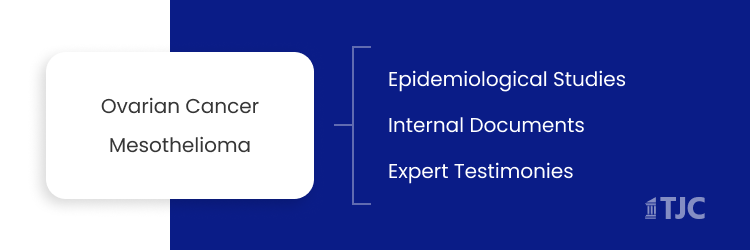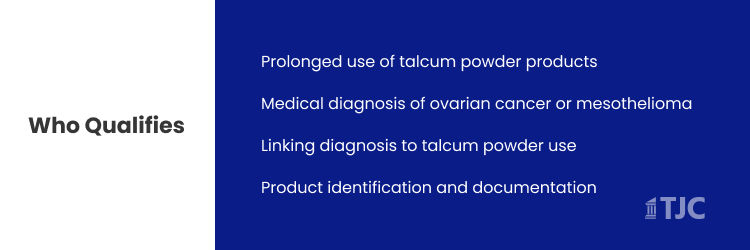Talcum powder has been a common household item for decades, especially popular for its use in baby powder products due to its moisture-absorbing properties.
However, in recent years, talc lawsuits have brought attention to potential health risks associated with these products. Claims of asbestos contamination, cancer risks, and corporate negligence have led to a series of high-profile lawsuits, particularly against Johnson & Johnson.
- Lawsuit Status: Ongoing with numerous cases consolidated in multidistrict litigation (MDL) and individual trials.
- Who Can File: Individuals diagnosed with ovarian cancer or mesothelioma after prolonged use of talcum powder products, typically containing asbestos contaminants.
- Estimated Time: Cases may take 1-3 years, depending on whether they are part of an MDL, settled out of court, or go to trial.
- Settlement Amounts: Settlements have ranged between $100,000 and $2.1 billion, with some jury verdicts awarding as much as $4.7 billion in punitive damages.
- Companies Involved: Johnson & Johnson is the primary defendant, along with Imerys Talc America and other manufacturers or suppliers of talc-based products.
Johnson’s baby powder, a popular item for decades, has been at the center of lawsuits alleging that the talc in these products is linked to ovarian cancer and lung cancer.
Johnson’s talc products, including Johnson’s talcum powder, are now facing intense scrutiny as baby powder lawsuits increase. Many women who developed ovarian cancer claim that their prolonged use of talcum-based baby powder led to serious health risks.
As these ovarian cancer lawsuits unfold, law firms representing plaintiffs in talc cases are pushing for compensatory damages for their clients.
Breaking Down the Talc Trial Saga
The talc bankruptcy filing, submitted by Johnson & Johnson, brought about a complex legal situation, with a bankruptcy judge, Michael Kaplan, overseeing the case. This move was part of the company’s strategy to manage the mounting talc liability and address talc claims more efficiently.
However, talc claimants voted on whether to proceed with this approach, as they sought fair compensation for their suffering. Law firms involved in multidistrict litigation have been critical, arguing that bankruptcy law shouldn’t shield companies from accountability in mass torts.
One of the most significant baby powder lawsuits involved a high-profile class action lawsuit with thousands of talcum powder plaintiffs. The case alleged that Johnson & Johnson and its talc supplier, Red River Talc, failed to disclose the cancer risks associated with prolonged talc use.
Plaintiffs’ talc powder lawyers argued that the company knew about the potential dangers, leading to lawsuits alleging negligence and seeking both compensatory and punitive damages. The Supreme Court has occasionally weighed in on aspects of talc cases, impacting how future talc trials may proceed.
The settlement of talc powder claims has been complicated, as many plaintiffs await a fair talc powder settlement. Lawyers representing talc plaintiffs have advocated for significant payouts, especially as some of the largest talcum powder settlements in history continue to unfold.
The company’s decision to put billions into a talc settlement fund was seen by some as an admission of responsibility, even as they maintained that Johnson baby powder is safe.
Is Talc Safe for Use?
Talc, a naturally occurring mineral, is prized for its ability to absorb moisture and reduce friction, which is why it has been widely used in cosmetic and personal hygiene products. Talcum powder products have been marketed for decades, especially for babies and adults to prevent rashes and keep the skin dry.
As far back as the 19th century, talcum powder was a common product in many homes. Johnson & Johnson, in particular, became a household name with its Johnson’s Baby Powder, a staple product used by millions worldwide.
The first talc powder lawsuit emerged when studies in 1982 began suggesting a potential link between the powder use and ovarian cancer. By 2009, cases were being filed in earnest, claiming that regular use of talc products in the genital area could contribute to the risk of cancer.
The primary allegations are based on claims that:
- Asbestos Exposure: Talc deposits may naturally contain asbestos due to the minerals’ proximity in the earth, which could lead to contaminated talc powder.
- Ovarian Cancer: Talc particles, when applied to the genital area, can potentially travel through the reproductive system and embed in the ovaries, potentially causing inflammation that leads to cancer.
- Mesothelioma: The inhalation of asbestos-contaminated talc is believed to contribute to mesothelioma, a rare but aggressive cancer directly linked to asbestos exposure.
Each of these claims is supported by scientific studies, epidemiological research, and anecdotal reports.
Johnson & Johnson’s Role and Response
Johnson & Johnson has maintained that their talcum-based baby powder and other talc products are safe and that they have always complied with regulatory requirements. The company asserts that their talc is pure, asbestos-free, and thoroughly tested to ensure consumer safety.
However, internal company documents revealed in court have shown that Johnson & Johnson was aware of the potential risks associated with asbestos in talc as early as the 1970s, sparking public outrage.
In its defense, Johnson & Johnson has argued that:
- Scientific Support: They cite numerous studies that suggest talc is safe and does not cause cancer.
- Testing: The company claims that its talc is routinely tested for asbestos and that it meets regulatory standards.
- Misinformation: Johnson & Johnson contends that media coverage and attorney advertising have spread misinformation about the risks associated with their products.
Actions Taken by Johnson & Johnson
In 2020, Johnson & Johnson announced it would discontinue the sale of talcum-based baby powder in North America, citing declining demand and “misinformation” about the product’s safety.
Despite this, they continue to sell a cornstarch-based alternative and still defend the safety of their talc products, asserting that they were unjustly targeted by lawsuits.
Talcum Powder Lawsuit Claims
The talcum cases involve several core claims, focusing on the connection between talc products and specific cancers.
Ovarian Cancer
Many plaintiffs allege that using talcum powder in the genital area over an extended period has led to ovarian cancer. The basis for this claim comes from studies that have found talc particles in ovarian tumors, suggesting that talc can travel through the reproductive system.
A 2016 study published in Epidemiology showed a possible increased risk of ovarian cancer among long-term talc users, though research is mixed, with some studies showing no significant link. However, the International Agency for Research on Cancer (IARC) classified genital use of talc-based powders as “possibly carcinogenic” to humans.
Mesothelioma
Mesothelioma is a rare cancer typically caused by asbestos exposure. Since talc and asbestos naturally occur together, there’s concern that some talc products may contain asbestos fibers. Lawsuits claim that manufacturers were aware of potential asbestos contamination but failed to warn consumers.
A study first published in Environmental Health Insights found trace amounts of asbestos in some talc samples, supporting concerns about asbestos-tainted talc.
Supporting evidence:
The evidence supporting these claims includes:
- Epidemiological Studies: Some studies have shown a correlation between talc use in the genital area and an increased risk of ovarian cancer.
- Internal Documents: Internal company documents indicate that some manufacturers were aware of asbestos contamination risks in talc.
- Expert Testimonies: Medical experts have testified to the plausibility of talc’s role in causing cancer, adding weight to plaintiffs’ claims.
Lawsuit Legal Basis
The legal foundation of talc litigation rests on well-established consumer protection and product liability principles. These lawsuits encompass several core legal theories:
Key Legal Arguments by Plaintiffs
Negligence
Plaintiffs contend that talc product manufacturers were negligent in ensuring the safety of their products. Asbestos-contaminated talc became a central issue, as companies were allegedly aware of the possibility of asbestos contamination during the talc mining process.
Given that talc and asbestos naturally occur in close proximity underground, plaintiffs argue that companies should have conducted rigorous testing to prevent contamination. Failure to do so, they claim, constitutes negligence.
Plaintiffs reference internal documents, some dating back to the 1970s, showing that companies like Johnson & Johnson were aware of asbestos contamination risks but did not disclose them.
Product Mislabeling
Product mislabeling is another critical element in these cases. Talcum products were marketed as safe and effective for daily hygiene, particularly for women and infants.
Plaintiffs argue that companies knowingly downplayed or ignored the potential risks, misleading consumers into believing that the powder was safe for routine use.
Failure to Warn
One of the most prominent legal claims in these cases is that manufacturers failed to provide adequate warnings about the potential dangers of using talcum powder.
Plaintiffs argue that companies had an obligation to disclose any health risks associated with their products, especially since the powder is commonly used in sensitive areas.
Impact on Case Proceedings
The courts have increasingly focused on internal communications and documents that reveal corporate awareness of the contamination risks. In many cases, juries have found the evidence compelling enough to award plaintiffs multimillion-dollar verdicts. This includes punitive damages intended to penalize manufacturers for their alleged misconduct.
The strength of these arguments, particularly in proving corporate knowledge and failure to warn, has been instrumental in the success of many talcum powder lawsuits. Courts nationwide have handed down verdicts against Johnson & Johnson and other manufacturers. Some awards have reached into the billions of dollars, underscoring the gravity of the allegations.
Talcum Powder Lawsuit Timeline
Below is a chronological look at the notable events that have shaped the lawsuit and the evolving legal landscape.
2019: Turning Point with Product Recall and Public Awareness
- October 2019: Amid growing scrutiny, J&J recalled 33,000 bottles of Johnson’s Baby Powder after FDA tests detected asbestos in some samples. Although J&J insisted on the product’s safety, this recall brought intense public focus to the allegations, setting the stage for future litigation and a change in consumer trust.
2020-2021: Bankruptcy Maneuvers and Supreme Court Decisions
- May 2020: Citing declining sales and “misinformation,” J&J halted sales of its talc-based baby powder in North America. This move sought to limit the company’s liabilities while maintaining that its products were safe.
- October 2021: J&J formed a subsidiary, LTL Management, transferring its talc-related liabilities to this new entity in an attempt to protect itself through a “Texas two-step bankruptcy.” LTL Management quickly filed for Chapter 11 bankruptcy to limit J&J’s financial exposure to future talcum powder lawsuits.
- June 2021: In a landmark ruling, the U.S. Supreme Court denied J&J’s appeal to overturn a $2.1 billion Missouri verdict awarded to 22 women diagnosed with ovarian cancer. This ruling not only supported plaintiffs’ claims but highlighted the potential health risks associated with talc-based products.
2022: Pushback Against Bankruptcy and Appeals Process
- September 2022: Attorneys representing plaintiffs actively contested LTL Management’s bankruptcy, arguing that J&J’s maneuver restricted claimants’ rights to pursue fair compensation. This legal pushback focused on exposing what many saw as an unfair strategy to limit liabilities.
2023: Bankruptcy Setbacks and Renewal of Settlement Efforts
- January 2023: The U.S. Court of Appeals for the Third Circuit dismissed LTL Management’s bankruptcy filing, a major setback for J&J. The court ruled that J&J could not use bankruptcy as a shield against multibillion-dollar liabilities, halting the Texas two-step strategy.
- April 2023: LTL Management refiled for bankruptcy in New Jersey and proposed an $8.9 billion settlement over 25 years to cover present and future talc claims. This was one of the largest settlement offers in product liability cases to date, highlighting J&J’s urgency to find a resolution.
- April 2023: Judge Michael Kaplan, overseeing the bankruptcy proceedings in New Jersey, nullified LTL’s prior bankruptcy filing, adding another twist to the already complex legal process.
2024: Renewed Negotiations and Ongoing Litigation Developments
- January 2024: J&J reached a $700 million settlement with over 40 U.S. states to resolve allegations of deceptive marketing practices around talc products. Though this settlement did not impact individual MDL cases, it demonstrated J&J’s attempt to settle as many claims as possible.
- March 2024: A Florida trial involving Bob Sugarman’s lawsuit for his late wife ended in a mistrial after the jury could not agree on a verdict. This outcome illustrated the complexity of proving causation in talcum powder lawsuits.
- April 2024: An Illinois jury awarded $45 million to the family of Theresa Garcia, who allegedly developed mesothelioma after using J&J’s baby powder. Around the same time, a Florida jury ruled in favor of J&J in a separate case, highlighting the varied outcomes across different jurisdictions.
- May 2024: J&J proposed a $6.48 billion settlement to resolve thousands of ovarian cancer claims, contingent upon plaintiffs agreeing to the settlement via bankruptcy proceedings. This marked J&J’s third attempt at a large-scale settlement facilitated through bankruptcy.
- June 2024: J&J agreed to a $700 million settlement with 42 states and the District of Columbia over deceptive talc marketing claims. Additionally, an Oregon jury awarded Kyung Lee $260 million after concluding that her mesothelioma was caused by years of using J&J’s baby powder.
- July 2024: A federal judge allowed J&J’s $6.48 billion settlement plan to proceed despite objections from some plaintiffs. In the same month, the International Agency for Research on Cancer reclassified talc from a “possible carcinogen” to a “probable carcinogen,” further supporting plaintiffs’ claims in ongoing lawsuits.
- August 2024: A South Carolina jury ordered J&J and co-defendant American International Industries to pay $63.4 million to Michael Perry, who attributed his mesothelioma to J&J’s talc products. This high-profile verdict added pressure on J&J amid settlement discussions.
- September 2024: To gain additional support for the settlement, J&J raised its proposed offer by $1.1 billion, totaling about $8 billion. This adjustment helped secure the necessary 75% plaintiff approval required by the bankruptcy court to move forward with the settlement.
- October 2024: The Department of Justice’s bankruptcy watchdog filed a motion to dismiss Red River Talc’s bankruptcy case, arguing it mirrors J&J’s previous failed settlement efforts. The trial to resolve these motions is expected to occur in early 2025, which could determine the fate of the proposed $8 billion settlement.
Current Status of the Talcum Powder Lawsuit
As of recent reports, over 38,000 cases have been filed against Johnson & Johnson (J&J) and other manufacturers, alleging links between talc-based products and cancers such as ovarian cancer and mesothelioma.
In response to rising claims, J&J has set aside $8.9 billion to address current and future talcum powder claims, though it denies any asbestos in its products. This fund, however, is contingent on court approval and acceptance by a majority of claimants.
A significant recent development includes J&J’s attempt to move talc liabilities into a subsidiary that filed for bankruptcy, a strategy facing intense legal scrutiny.
This approach, called the “Texas Two-Step,” aims to limit payouts, but courts are divided on its legality. Meanwhile, there are ongoing class-action lawsuits consolidating individual cases, allowing for faster processing and possible settlements.
Active litigation continues in both state and federal courts, with mixed verdicts and some awards exceeding $2 billion in damages, signaling ongoing momentum in these lawsuits. The next phases of litigation will focus on settlements and court rulings on J&J’s restructuring plan.
Legal Strategies Employed by Both Parties
Johnson & Johnson’s Strategy:
J&J’s primary approach has been to utilize the “Texas two-step” bankruptcy, isolating its liabilities in LTL Management to seek Chapter 11 protection. This strategy, while controversial, was designed to shield J&J from large-scale financial judgments while offering a structured settlement through bankruptcy.
Repeated setbacks, including court rejections and plaintiff objections, have required J&J to revise and increase their settlement offers multiple times to gain the necessary approvals.
Plaintiffs’ Strategy:
Plaintiffs’ legal teams have focused on challenging the validity of J&J’s bankruptcy filings, arguing that these actions unjustly protect the company at the expense of fair compensation.
By presenting compelling evidence, including internal J&J documents, plaintiffs have worked to highlight the alleged health risks linked to asbestos in talc products. Their persistent legal arguments and appeals against J&J’s bankruptcy maneuvers have led to significant jury awards and put continuous pressure on J&J to settle.
Talcum Powder Lawsuit Average Settlements
The settlement amounts in talcum powder lawsuits have varied widely based on the circumstances of each case, the type of cancer involved, and the strength of the evidence. Some settlements have reached millions of dollars, with high-profile cases setting significant precedents in product liability litigation.
How Settlements Are Reached
Settlements in talc lawsuits are typically negotiated out of court, allowing both parties to avoid the lengthy and uncertain trial process. In these cases, plaintiffs’ legal teams and defendants weigh potential court trial outcomes against the certainty of a settlement. The following factors play a crucial role in influencing settlement amounts:
Medical Condition
On average, cases involving mesothelioma have seen settlements between $1 million and $1.4 million, given the cancer’s high treatment costs and mortality rate.
Proof of Talc Usage
Plaintiffs with documented evidence of prolonged use of talcum powder products have stronger cases. This evidence may include purchase records, testimonies, or medical records linking product use with diagnosis. Cases with detailed, long-term usage evidence often achieve settlements on the higher end of the spectrum, ranging from $500,000 to $2 million.
Strength of Evidence
Strong evidence, such as internal company documents or studies showing links between asbestos-contaminated talc and cancer, has led to higher settlements.
In cases where plaintiffs could prove that a manufacturer was aware of asbestos risks but failed to warn consumers, punitive damages have sometimes been awarded. These damages have pushed settlement amounts to $5 million or more.
Average Settlement For Talcum Powder Lawsuit
While exact settlement figures vary and many remain confidential, information from past cases provides some insights:
Individual Settlements
For individual cases of ovarian cancer linked to talcum powder, average settlements typically range between $100,000 and $1 million, depending on the extent of harm and available evidence.
For example, some ovarian cancer cases that lacked strong evidence of corporate negligence but were linked to prolonged product use received settlements closer to $100,000–$300,000. Stronger cases with more compelling evidence often see settlements in the range of $1 million or higher.
Mesothelioma Cases
Due to the cancer’s severity and the established link between asbestos and mesothelioma, mesothelioma cases generally achieve higher settlements. These settlements average between $1 million and $2.4 million. High-profile cases with clear evidence of corporate negligence or intent to withhold safety information have even led to individual awards as high as $10 million.
Class Action Settlements
Class action cases, where groups of plaintiffs file collectively, tend to yield lower individual compensation amounts per person due to the large number of claimants sharing the award.
On average, individual claimants in class action suits may receive between $10,000 and $100,000, with the total settlement amount for the group sometimes reaching up to $100 million.
For instance, in one talcum powder class action case, Johnson & Johnson agreed to a settlement of $100 million to resolve approximately 1,000 claims. Each claimant received a share based on the severity of their case and the length of their exposure to the product.
Differences Between Individual and Class Action Settlements
In individual cases, plaintiffs may receive larger talc powder settlements or verdicts, particularly if they have unique or particularly compelling evidence. These cases require more personalized legal attention and can lead to higher settlements, especially if punitive damages are awarded.
Class action suits, which involve numerous plaintiffs with similar claims, usually lead to a pooled settlement amount divided among claimants. While less individualized, class actions allow more people to seek justice, even if the compensation per person is smaller.
In these cases, plaintiffs may receive less, but they benefit from a faster resolution and avoid the need to present individualized evidence.
Notable Cases in the Talcum Powder Lawsuit
Here are some of the most impactful cases in the talcum powder lawsuit:
2016 – Jacqueline Fox Case
In one of the earliest and most publicized cases, Jacqueline Fox was posthumously awarded $72 million by a Missouri jury.
Fox, who had used the Johnson company’s Baby Powder for over 35 years, developed ovarian cancer and ultimately lost her life to the disease. During the trial, internal documents were presented that suggested Johnson & Johnson had been aware of the potential cancer risks associated with talc.
2018 – 22 Plaintiffs Case
One of the most significant cases to date involved 22 women who claimed they developed ovarian cancer after long-term use of Johnson & Johnson’s talc products.
In July 12, 2018, a Missouri jury awarded these plaintiffs a total of $4.69 billion—a record-breaking amount in talcum powder cancer lawsuits. The jury was reportedly influenced by evidence indicating that Johnson & Johnson may have knowingly exposed consumers to talc that was contaminated with asbestos.
This case marked the single largest verdict against the company and underscored the seriousness of the alleged health risks.
Berg Case
Diane Berg’s 2009 case was one of the first talcum powder cancer lawsuits to gain public attention. Though Berg did not receive a financial award, her case highlighted critical internal documents and research that pointed to potential contamination risks.
Berg’s perseverance and public advocacy encouraged other plaintiffs to come forward, setting the stage for the subsequent wave of litigation. Her case raised awareness of the need for thorough testing and transparency regarding product safety.
2019 – Leavitt Case
In 2019, California resident Teresa Leavitt was awarded $29 million after a jury found that she had mesothelioma. Leavitt’s legal team presented evidence of asbestos fibers in Johnson & Johnson’s products, which reportedly led to her condition.
The Leavitt case emphasized the role of asbestos in talc-based products and held Johnson & Johnson accountable for alleged negligence in failing to warn consumers of the risks.
2019 – Carolyn Weirick Case
Carolyn Weirick, another California plaintiff, claimed that her mesothelioma was caused by the talc containing asbestos in Johnson & Johnson’s products. A jury initially awarded Weirick $40.3 million, though the case was later reversed on appeal.
Nonetheless, this case gained significant media attention and contributed to the growing legal and public pressure on Johnson & Johnson regarding its talcum products. It underscored the widespread concerns about asbestos contamination and its potential effects on consumer health.
2020 – Barden Case in New Jersey
In 2020, a New Jersey jury awarded $750 million in punitive damages to four plaintiffs who claimed that talc-based baby powder led to their cancer diagnoses. This case involved Johnson & Johnson’s efforts to appeal the verdict, ultimately resulting in a reduction of the damages.
Still, the Barden case underscored the juries’ strong stance on punitive measures against companies they believed acted irresponsibly in marketing talcum powder without disclosing potential health risks.
2021 – Cristobal Colon Case
In New York, Cristobal Colon was awarded $15 million in 2021 after alleging that his mesothelioma was caused by asbestos exposure from powder use.
Colon had used talcum powder regularly, and the trial revealed evidence that supported his claim. This case contributed to the precedent that talc manufacturers could be held liable for conditions linked to asbestos in talc products.
Who Qualifies for the Talcum Powder Lawsuit
To qualify for the lawsuit, individuals must meet a certain eligibility criteria. This section outlines the primary requirements that can establish a strong foundation for a talcum powder claim:
Prolonged Use of Talcum Products
- Plaintiffs must demonstrate consistent and prolonged use of talc powder products, especially those used in personal hygiene.
- Common talcum products cited in lawsuits include Johnson & Johnson’s Baby Powder and other talc-based body powders.
- A history of regular, long-term use strengthens the connection between the product and the alleged health effects.
Medical Diagnosis of Ovarian Cancer or Mesothelioma
- Ovarian cancer claims often involve women who used talcum powder in the genital area over many years.
- Mesothelioma claims generally involve individuals who may have inhaled asbestos-contaminated talc.
- A confirmed medical diagnosis of one of these conditions is critical for pursuing a claim.
Linking Diagnosis to Talcum Powder Use
- Plaintiffs need to demonstrate that their exposure to talc-based products likely contributed to their condition.
- This may involve medical records, scientific evidence, and expert testimonies to support the argument that talcum powder was a contributing factor in their cancer diagnosis.
Product Identification and Documentation
- Proof of product use, such as receipts, product packaging, or testimonies, strengthens the case.
- While some plaintiffs may not have kept receipts, a detailed account of their talcum powder usage and familiarity with specific brands or products can support their claim.
How to File a Claim in the Talcum Powder Lawsuit
Here’s a step-by-step guide to help potential plaintiffs through the process:
1. Gather Documentation of Product Use
Begin by gathering all available documentation that shows you used talcum-based baby powder or similar products over a prolonged period.
While receipts are helpful, most people do not keep such records for everyday items. Alternatives may include witness statements from family or friends, photographs, or even social media posts that indicate the product’s presence in your daily routine.
2. Collect Medical Records
Collect medical documentation that proves your diagnosis of ovarian cancer or mesothelioma. This may include pathology reports, doctor’s notes, and treatment records. Your lawyer will use these records to build a medical timeline that links your diagnosis to your powder use.
3. Consult a Specialized Lawyer
Find a lawyer who specializes in product liability or mass tort cases. An experienced attorney can provide a free case evaluation to determine if you have a strong case. Talcum powder lawyers understand the nuances of these cases.
4. Determine Your Filing Type: Individual or MDL
Your attorney will help you decide whether to file your case as an individual talc lawsuit or as part of a talcum powder MDL (multidistrict litigation). MDLs consolidate similar cases for more efficient handling in court, which can often lead to faster settlements or verdicts. In some cases, individual filings may be preferable, especially if unique circumstances apply.
5. File the Claim with Your Attorney’s Assistance
Once your attorney has assessed your documentation and medical records, they will file your claim on your behalf. This involves submitting a complaint that outlines the allegations, including negligence, product mislabeling, and failure to warn, and detailing the specific damages you are seeking.
Talcum Powder Lawsuit FAQs
Here are the answers to some of the most commonly asked questions related to the talcum powder cases:
Can I Still Join if I Wasn’t Part of Earlier Filings?
Yes, you may still be eligible to file a baby powder lawsuit even if you weren’t involved in the earlier filings. Courts allow new plaintiffs to join ongoing talcum powder litigation with a law firm as long as they meet the eligibility criteria.
If you have documented use of talcum powder products and a medical diagnosis that can be linked to talcum powder, you may still have a viable claim. However, it’s essential to act promptly, as each state has a statute of limitations, or a time limit, for filing personal injury claims.
Take Note: Consulting a lawyer can help you determine whether you’re still within the allowable timeframe for filing.
Is Talcum Powder Still Sold in the US?
Yes, talcum powder products are still available in the United States. For instance, Johnson & Johnson discontinued its talc-based baby powder in North America in 2020 due to declining demand and ongoing litigation concerns.
However, powder is still sold by various brands for cosmetic and personal hygiene purposes. For consumers concerned about potential risks, it’s advisable to check product labels to confirm if the powder is talc-based.
What Is a Safe Alternative to Talcum Powder?
For those seeking safer alternatives, cornstarch-based powders are widely recommended. Cornstarch powders offer similar moisture-absorbing properties and are free from the risks associated with talc.
In addition to cornstarch, other alternatives include arrowroot powder, baking soda-based powders, and kaolin clay. All of which provide similar benefits for personal hygiene without the potential health concerns linked to talc powder.
Conclusion
The new talcum powder lawsuits have raised important questions about consumer safety, transparency, and corporate accountability. With thousands of cases still pending, this lawsuit continues to evolve, bringing new updates and developments every month.
Johnson & Johnson and other companies face ongoing legal pressure, with significant verdicts and settlements that have highlighted the potential health risks linked to talc powder products.
For those affected, it’s natural to feel a mix of frustration and concern. After all, talc powder has been a staple in households for generations, trusted by millions for its everyday uses.
The mounting evidence and lawsuits, however, have led many to reconsider its safety. Consumers who believe they may have been harmed by these products still have options to explore a legal claim, especially as more information and resources become available.
Looking ahead, the outcome of the lawsuit could lead to lasting changes. Companies might adopt stricter safety testing, improve transparency, or move to safer ingredients. For individuals considering joining the lawsuit, consulting with a knowledgeable talcum powder lawyer can provide insight into eligibility and options moving forward.
And for all consumers, staying informed and understanding product labels can help make safer choices in the future.
Disclaimer: The information provided in this article is for informational purposes only and does not constitute legal advice. Readers should not act or refrain from acting based on this information without seeking appropriate legal counsel from a licensed attorney. The content is not intended to create, and receipt or viewing of it does not establish an attorney-client relationship.




